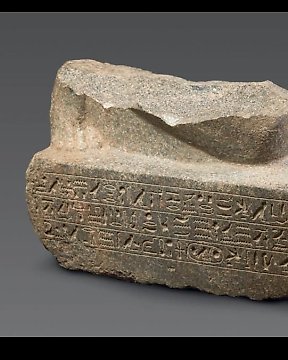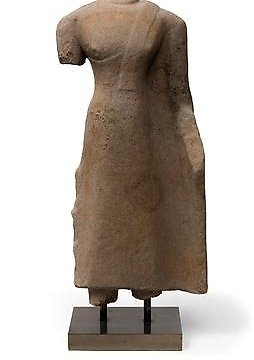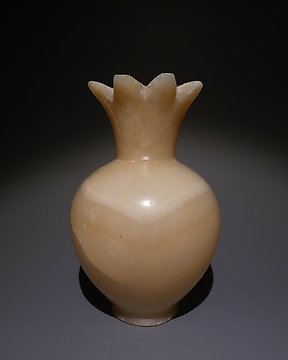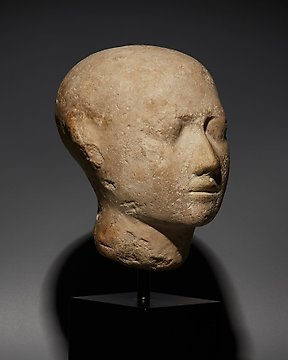goede foto's, goede omschrijving, goed verpakt en snel verzonden.
Vizualizați traducereaEgiptul Antic Piatră Capul unei sculpturi a zeului Serapis. Perioada ptolemaico-romană, 332 î.Hr. - secolul I d.Hr. 9,5
Nr. 84870751
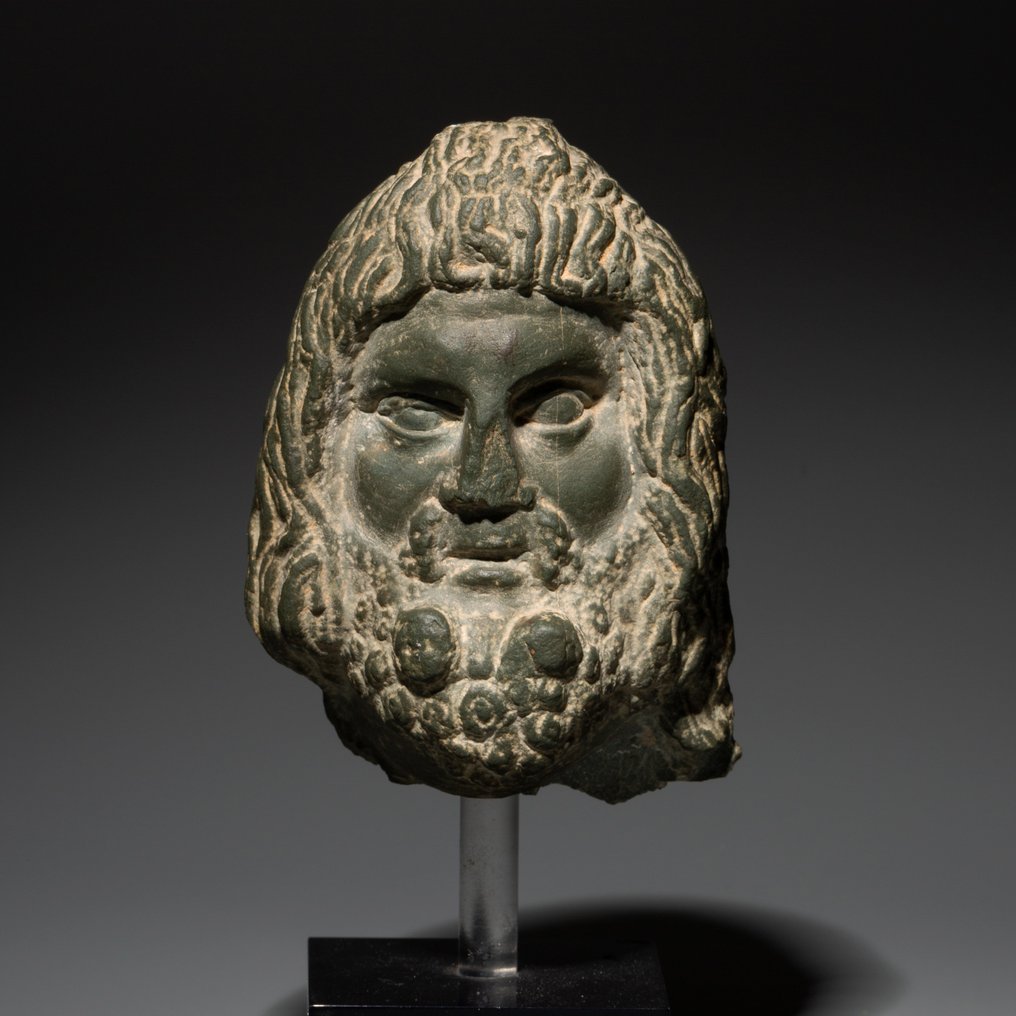

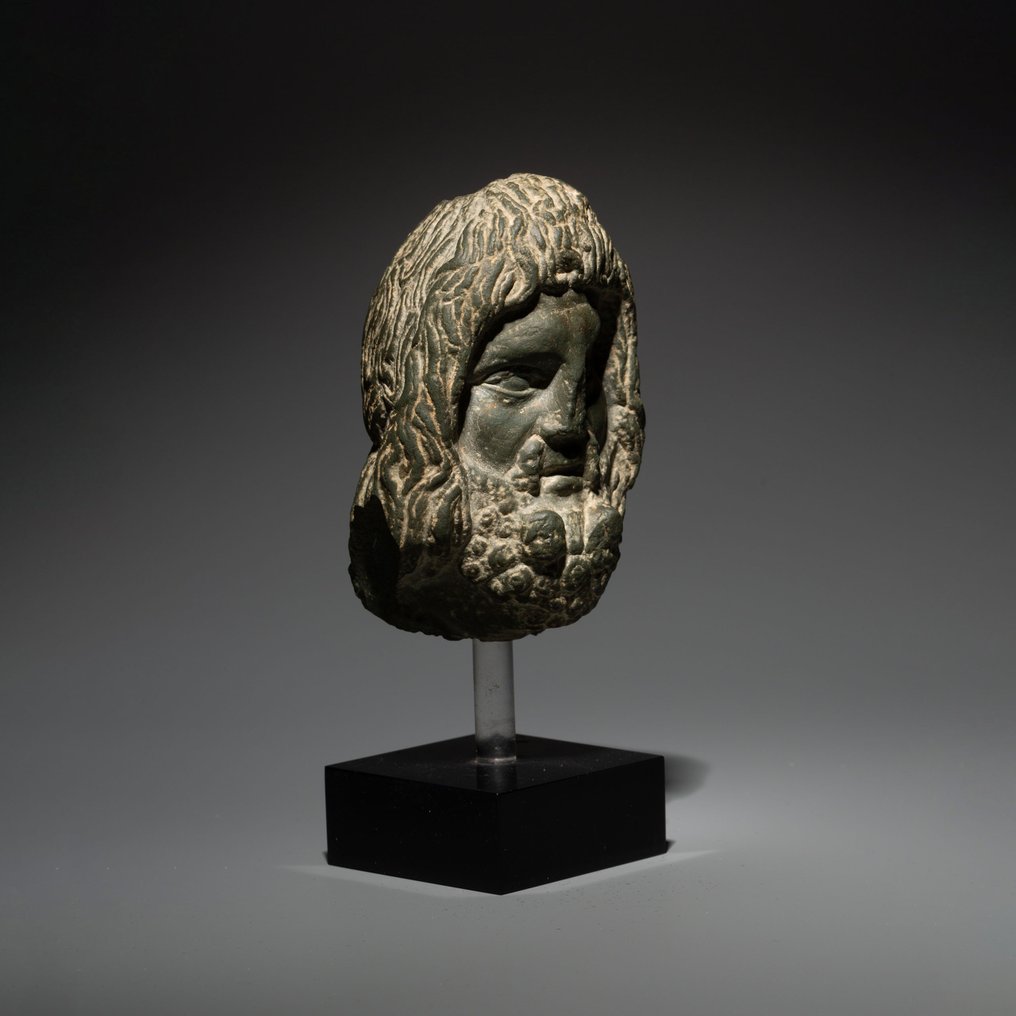
Head of a sculpture of the god Serapis.
- very fine surface -
Ancient Egypt, Ptolemaic-Roman period, 332 BC. - 1st century AD.
Schist.
9.5 cm height, 14 with the stand.
Condition: Good general state of preservation, with wear on the nose.
Provenance: Private collection Paris, France, 1960 - 1970.
Description:
The Cult of Serapis was promoted by Ptolemy I Sotar (Ptolemaic dynasty) as a means of fostering harmony between his Egyptian and Greek subjects. The god combined Osiris and the Apis Bull (the sacred bull of Memphis) with aspects of the Greek gods Zeus (the king of the gods), Dionysus (also known as Bacchus, the god of wine), Helios (the personification of the Sun), Hades (the god of the underworld) and Asklepios (god of medicine).
Linguistically, his name is the result of the fusion of Osiris and Apis, and there is evidence that a cult of Osarapis existed before the Ptolemaic Period, but the Ptolemaic version was a more Greek conception.
Serapis personified divine majesty and represented the sun, fertility, healing, and the afterlife. His consort was Isis, the wife of Osiris and the most popular goddess during the Ptolemaic Period.
Serapis was depicted as a man with an elaborate Greek hairstyle wearing Greek style robes and a full beard. He often wears a corn modius or sheaf on his head. Less often, he is depicted as a serpent in recognition of his connection with the underworld and fertility.
Ptolemy built the Serapeum in Alexandria as the cult center of the new god and it remained the focus of pilgrimage until it was destroyed by the Emperor Theodosius in AD 389. Other smaller shrines and temples were constructed or adapted throughout Egypt, and the cult even spread to Roman territories.
The Serapeum in Saqqara (the home of the Apis bull) grew in popularity with the Greeks thanks to the connection with Serapis, but the native Egyptians never really took to this Hellenized version of Osiris.
Notes:
- The piece includes authenticity certificate.
- The piece includes Spanish Export License (Passport for European Union) - If the piece is destined outside the European Union a substitution of the export permit should be requested, can take between 1-2 weeks maximum.
- The seller guarantees that he acquired this piece according to all national and international laws related to the ownership of cultural property. Provenance statement seen by Catawiki.
Povestea Vânzătorului
Head of a sculpture of the god Serapis.
- very fine surface -
Ancient Egypt, Ptolemaic-Roman period, 332 BC. - 1st century AD.
Schist.
9.5 cm height, 14 with the stand.
Condition: Good general state of preservation, with wear on the nose.
Provenance: Private collection Paris, France, 1960 - 1970.
Description:
The Cult of Serapis was promoted by Ptolemy I Sotar (Ptolemaic dynasty) as a means of fostering harmony between his Egyptian and Greek subjects. The god combined Osiris and the Apis Bull (the sacred bull of Memphis) with aspects of the Greek gods Zeus (the king of the gods), Dionysus (also known as Bacchus, the god of wine), Helios (the personification of the Sun), Hades (the god of the underworld) and Asklepios (god of medicine).
Linguistically, his name is the result of the fusion of Osiris and Apis, and there is evidence that a cult of Osarapis existed before the Ptolemaic Period, but the Ptolemaic version was a more Greek conception.
Serapis personified divine majesty and represented the sun, fertility, healing, and the afterlife. His consort was Isis, the wife of Osiris and the most popular goddess during the Ptolemaic Period.
Serapis was depicted as a man with an elaborate Greek hairstyle wearing Greek style robes and a full beard. He often wears a corn modius or sheaf on his head. Less often, he is depicted as a serpent in recognition of his connection with the underworld and fertility.
Ptolemy built the Serapeum in Alexandria as the cult center of the new god and it remained the focus of pilgrimage until it was destroyed by the Emperor Theodosius in AD 389. Other smaller shrines and temples were constructed or adapted throughout Egypt, and the cult even spread to Roman territories.
The Serapeum in Saqqara (the home of the Apis bull) grew in popularity with the Greeks thanks to the connection with Serapis, but the native Egyptians never really took to this Hellenized version of Osiris.
Notes:
- The piece includes authenticity certificate.
- The piece includes Spanish Export License (Passport for European Union) - If the piece is destined outside the European Union a substitution of the export permit should be requested, can take between 1-2 weeks maximum.
- The seller guarantees that he acquired this piece according to all national and international laws related to the ownership of cultural property. Provenance statement seen by Catawiki.
Povestea Vânzătorului
- 754
- 7
- 0
molto bello tutto ok
Vizualizați traducereaPezzo come da descrizione, davvero notevole. Venditore molto consigliato in quanto gentile e disponibile. spedizione molto veloce. Ottimo!
Vizualizați traducereaVenditore davvero ottimo e gentile. Merce come da descrizione, spedizione veloce. Ottimo l'avere certificato di autenticità.
Vizualizați traducereaUn 100 como empresa un 100 como envío . Empresa muy especial con mucha exquisitez en todos los productos y en personal . Muchas gracias
Vizualizați traducereaAll well! Thanks.
Vizualizați traducereaVery nice and fine cut little jewel! Well packed too! Thanks!
Vizualizați traducereanice piece and very fast shipping!
Vizualizați traducereaEs una maravilla de moneda, donde se le nota los pasos de los años y me encanta. Servido muy rápido y bien empaquetado. Con su certificación. Qué más se puede pedir?
Vizualizați traducereaSnelle en correcte levering, alleen was de verpakking voor het schilderij niet stevig genoeg.
Vizualizați traducereaHerzlichen Dank!
Vizualizați traducereaAll OK and with very fast shipping.
Vizualizați traducereaPrachtig schilderij. Zo blij mee. Zeer nette verkoper en zeer snelle levering.
Vizualizați traducereaperfect ! very fast and high quality delivery !
Vizualizați traducereaAll well! Thanks.
Vizualizați traducereaVendeur très professionnel, top +++×
Vizualizați traducereaPhotos trop contrastées pour bien percevoir les défauts, mais ces défauts étaient visibles pour autant. Le "Bon état" est trompeur. Sinon, envoi rapide et correctement emballé. Frais de port exagérés.
Vizualizați traducereaGreat communication, delivery and product. Came with a well made certificate of authenticity and good packaging. Overall very happy with the purchase! Delivery is a bit expensive, but I recommend it
Vizualizați traducereaMagnifique témoin du passé, envoyé avec tous les justificatifs, impeccable. Encore une fois très satisfait, un grand merci
Vizualizați traducereaThank you for the Special offer and the fast shipping of this excellent piece of art!
Vizualizați traducereavery good description of the object, very good price for this rare item,. Fast sending (has been at my place 2 days after buying!). Definitely would buy again.
Vizualizați traducereaSehr schön
Vizualizați traducereaAs described, perfect logistic
Vizualizați traducereagreat seller, everything came as should with certificate of authenticity
Vizualizați traducereaExceptionally well packaged, description aligned with positing received
Vizualizați traducerea- 754
- 7
- 0
goede foto's, goede omschrijving, goed verpakt en snel verzonden.
Vizualizați traducereaDeclinarea responsabilității
Vânzătorul garantează și poate dovedi că obiectul a fost obținut în mod legal. Vânzătorul a fost informat de către Catawiki că trebuie să furnizeze documentația cerută de legile și reglementările din țara de reședință. Vânzătorul garantează și are dreptul de a vinde/exporta acest obiect. Vânzătorul va furniza cumpărătorului toate informațiile disponibile cu privire la proveniența obiectului. Vânzătorul se asigură că toate autorizațiile necesare sunt/vor fi puse la punct. Vânzătorul va informa imediat cumpărătorul cu privire la eventualele întârzieri în obținerea unor astfel de autorizații.
Vânzătorul garantează și poate dovedi că obiectul a fost obținut în mod legal. Vânzătorul a fost informat de către Catawiki că trebuie să furnizeze documentația cerută de legile și reglementările din țara de reședință. Vânzătorul garantează și are dreptul de a vinde/exporta acest obiect. Vânzătorul va furniza cumpărătorului toate informațiile disponibile cu privire la proveniența obiectului. Vânzătorul se asigură că toate autorizațiile necesare sunt/vor fi puse la punct. Vânzătorul va informa imediat cumpărătorul cu privire la eventualele întârzieri în obținerea unor astfel de autorizații.




